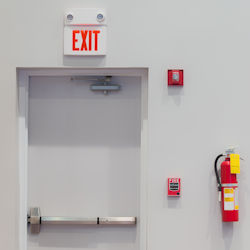Audible Alarms
Audible alarms include bells, horns, sirens, voice announcement systems, and other devices that can be distinguished above and apart from the normal sound level within the workplace.
Only temporal signals or voice signals are approved by NFPA 72 for new audible alarm systems because they are the most effective alarm systems.
Temporal Coded signals
Temporal coding is accomplished by interrupting a steady sound in the following manner:
- Use the following repeating cycle: .5 sec ON; .5 sec OFF; .5 sec ON; .5 sec OFF.
- Use a distinctive three-pulse temporal pattern to signal an immediate emergency evacuation. The signal must consist of a "three-pulse" temporal pattern described in ANSI/ASA S3.41, Audible Emergency Evacuation (E2) and Evacuation Signals with Relocation Instructions (ESRI).
- Only use this signal pattern to notify personnel of the need to immediately evacuate the building. Total evacuation is not always desirable or necessary during an emergency therefore there should be a different signal pattern assigned to signify the need for relocation of the occupants from the affected area to a safe area within the building or for a "shelter in place".
Voice Signals
A workplace announcement system using speakers can be used to play a live or recorded voice message. They are often ideally suited for large workplaces where phased or guided evacuations are needed.
Bells, Horns, and Sirens
The following bells, horns and sirens, are only permitted in existing systems. They are not approved for new systems.
- Bells: Vibrating bells are the most common signal device. Bells are commonly used in schools for fire alarms.
- Horns: Horns produce a very loud distinctive sound that immediately attracts attention. Horns can be useful to call attention to critical situations.
- Sirens: Sirens produce a loud piercing wail that makes them ideally suitable for initiating a site-wide evacuation.
Knowledge Check Choose the best answer for the question.
4-3. Which of the following are allowed in new audible alarm systems?
You forgot to answer the question!

